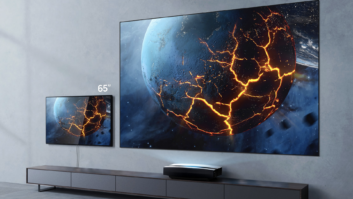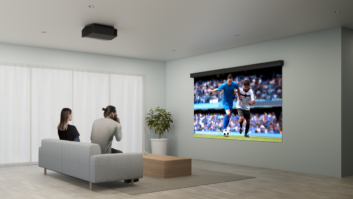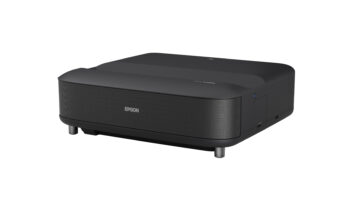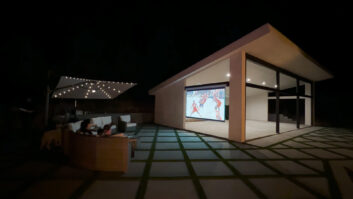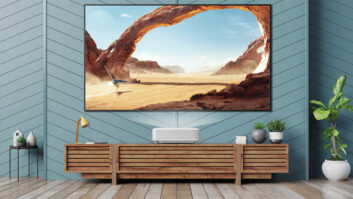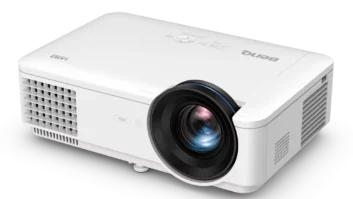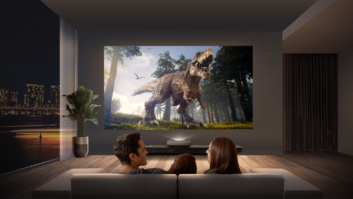Kudos: Quick setup; great sound for an all-in-one; sharp lens focus and detail
Concerns: No Netflix; HDR colors can be off; true “day viewing” requires an ALR screen; getting cabinet/screen height locations in sync may be a challenge
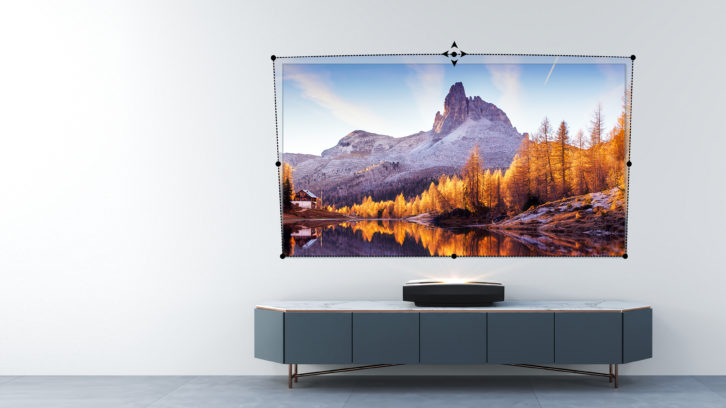
Serendipity. It’s the occurrence and development of events by chance in a happy or beneficial way. Or, when something unexpected turns out to be a good thing. And that’s what transpired to bring the new Xgimi Aura Ultra-Short-Throw (UST) projector into my possession for this review.
I originally reached out to Xgimi’s PR team following CES trying to get hold of the Horizon Pro, one of the company’s new portable projectors, but when the box arrived, I knew it was far too large to be considered portable by even the most generous of definitions.
So, what does an equipment reviewer do when a brand new 4K UST laser projector shows up unexpectedly on his porch? He unboxes it, connects it, and starts watching!
While UST projection is still a relatively new-ish option in the home theater world, it’s one that has been steadily gaining traction and was on display from numerous companies at this year’s CES and the recently completed CEDIA Expo. Along with well-known projector manufacturers like Hisense, Samsung, LG, Sony, BenQ, Epson, and Optoma, there are many other players that are entering this market looking to make a name for themselves. To that list, you can add Vava, Wemax, Formovie, ViewSonic, AWOL Vision, and Xgimi.
Rather than the typical, dedicated, light-controlled movie room where you typically see projectors installed, UST models combined with Ambient Light Rejecting (ALR) screens are often touted as TV replacements, meant to be put in more typical multi-use spaces like family rooms; often, they are all-in-one units with a built-in sound system and streaming support.
If you’ve never installed or played with a UST projector before, then we’re in the same boat.
Appearance
My first thought on unboxing was, “Man, this thing is heavy.” At nearly 24 pounds, the Aura feels solid and substantial.
While this is my first go-around installing and living with a UST projector, this certainly isn’t the first time I’ve seen one. And due to the nature of their design, lens, and light path, all UST projectors look rather similar in outward appearance, with a recessed slot on top for the lens, a speaker grille facing viewers, and connections on the back facing the screen.
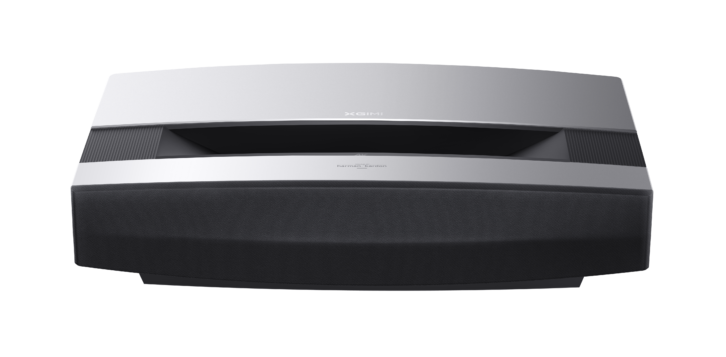
Even so, the Aura makes the most of its looks, and since it will be sitting front and center wherever you decide to watch, that’s a good thing. At 23.85 x 15.79 x 5.49 inches (H x W x D), it has a sizable footprint, so you’ll appreciate the style that went into the design. The top is rounded and finished in a charcoal-silver color with a black area that houses the recessed lens and fans. The front is covered with black speaker grille to conceal the Harman Kardon audio system. All inputs and connections are around back (toward the screen), giving the Aura a nice, clean look.
My second thought on unboxing was, “Man, tech has come a long way!” It was just a few years ago that I saw my first UST — a Sony demo at CES — and that model sold for $20,000. Here, Xgimi is delivering 4K HDR resolution, with a laser-light engine capable of producing 2400 ANSI lumens and rated for a 20,000-hour lifespan, for under $2500.
The Tech
The Aura uses Texas Instruments’ DLP technology, utilizing a single .47-inch DMD (Digital Micromirror Device) chip that contains 2.1 million micromirrors. In order to turn 2.1 million micromirrors (1920 x 1080) into the 8.3 million pixels required for 4K resolution (3840 x 2160), the chip does some incredibly fast switching — 60 times per second — to shift pixels in both the vertical and horizontal directions to produce 4K resolution onscreen. This process all happens so quickly that it is imperceptible to our vision, with our brains merging this into a single image.
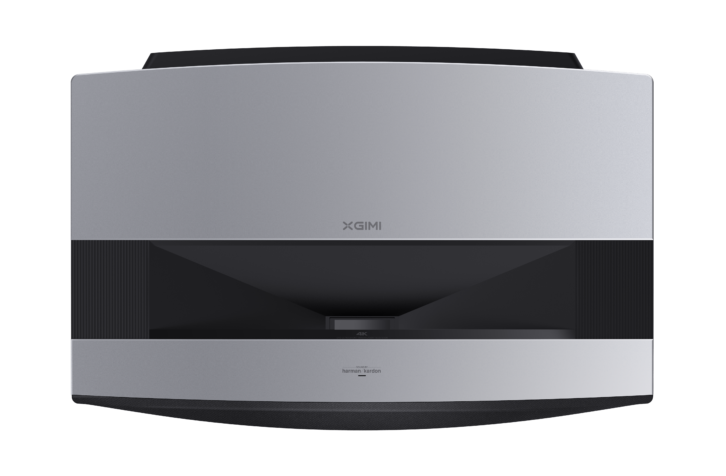
If you recall hearing the term “wobulation” back in the day, this is essentially what is happening, but with more pixels for the 4K age. Of course, video purists are loath to call this “true 4K,” as there aren’t actually 8.3 million discrete pixels, as with Sony and JVC projectors.
Another couple of terms you’re likely to encounter when looking at UST laser projectors are “single laser” and “triple laser.” Triple laser, as the name implies, uses three different lasers — red, green, and blue — to produce the image onscreen.
And as you’d surmise, a single-laser model, like the Xgimi Aura, uses just one blue laser that is split and run through a color wheel and prism to make all of the colors. This is a similar process to what is employed with all lamp-based, single-chip DLP projectors.
Because of the color wheel employed by single-chip DLP projectors — laser or otherwise — it can introduce a viewing artifact known as “the rainbow effect,” where you can occasionally see some color trails onscreen. Some viewers — often younger ones — are susceptible and sensitive to this. I noticed them occasionally, usually late at night when I was tired and would look away and then back to the screen, but my 15-year-old daughter saw them more frequently.
The final piece of the puzzle is the lens that throws the image nearly straight up onto the screen while sitting just inches away from the wall. Xgimi says the minimum screen size is 80 inches diagonal (16×9 aspect ratio) with a maximum of 120 inches. The Aura lens has a throw-ratio of .233:1, meaning for an 80-inch image, the back of the unit sits just 4.3 inches from the screen and the full 150-inch image requires the front to sit 17.3 inches from the screen.
Installation
The actual installation process is stupid simple: center the Aura horizontally in front of the screen on something flat and level, move it forward and back until the image fills the screen, then tow it in/out a bit until you get it squared to the screen. The whole process takes just a few moments.
The rub is, there are no physical lens adjustments whatsoever, and getting the correct height between the bottom of the projector — whatever it is sitting on — to the bottom of the screen is non-negotiable and might be your biggest challenge. There are some adjustable feet on the bottom if you need to tweak/level here and there, and you can rear-mount the projector.
For me, I had an existing 92-inch Draper M1300 motorized screen along with a Salamander equipment rack. For my screen size, the Aura needed to sit about 6.1 inches below the bottom of the screen, but my stand was slightly too high, meaning I couldn’t get the image to quite fill all the way to the bottom and sides of my screen. (I got about 88 inches instead of 92.)
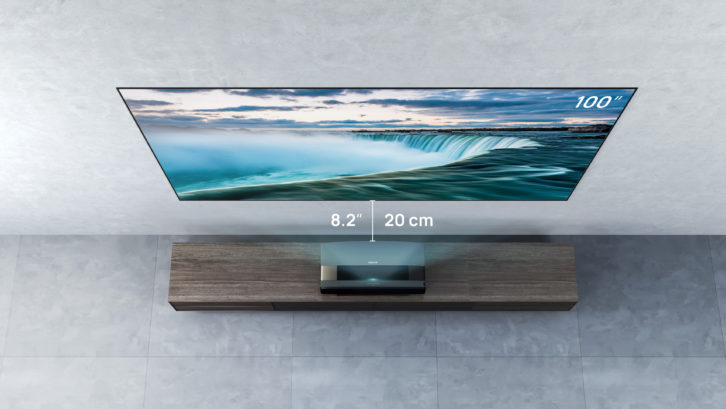
So, when considering installing the Aura — or any UST projector for that matter — there will be a chicken-and-egg decision you’ll have to go over with the homeowner where the furniture the projector sits on will affect the image size and screen location. If you are dealing with an existing screen, you’ll need to make sure you can position the Aura correctly. (The requisite dimensions are all clearly laid out in the Aura manual.)
Once you get the projector as optimally positioned as possible, there is still the chance that you won’t have all edges perfectly aligned. Aura includes a quick and easy 8-port correction that lets you bump things a bit here and there to get it as square as possible. There is no masking or blanking to remove any overspray.
Tapping the bottom button on the remote throws up a pattern on the screen and initiates a quick auto-focus. You can also go into the settings menu if you want to manually tweak the focus a bit, but I never felt the need.
The remote isn’t backlit, which is always a bummer, and I frequently found myself hitting the wrong button, which either started the auto-focus, took me back to the home screen, or brought up the settings screen. The remote does have a Google Assistant button, but it is kind of slow to respond.
Once the unit is positioned, it installs much like any other display, with a generous number of inputs and outputs. There are three HDMI 2.0 inputs, with input one supporting ARC, two USB 2.0 inputs, and a mini-jack analog and Toslink optical digital audio output for connecting to a separate audio system.
Another of Aura’s big features is the included Harman Kardon sound system that offers dual woofers and tweeters, all individually powered by 15-watt amplifiers. The unit also boasts DTS and Dolby audio decoding, and it does an admirable job of delivering decent audio performance, with some nice width to the presentation and clear dialog delivery. It also delivers enough audio oomph to fill a mid-sized room and produces enough bass to give it some weight. While a soundbar would be an improvement, this can certainly stand on its own and is one of the better built-in speaker systems I’ve experienced.
The Aura is a full-fledged streaming device with Android 10 TV built in. This requires a connection to the internet, which can either be hardwired or via Wi-Fi (both 2.4 and 5 GHz supported). If you’ve installed/set up an Android-powered TV before (i.e., any Sony model), then this process is very familiar.
Once connected, you can download the many apps available from the Google Play store. Many of them, except Netflix. (Well, technically you can download and install Netflix, it just won’t work.) According to Xgimi, “Netflix only authorizes very few projector brands so far. However, we know that Netflix is very important, especially for our customers, so we are already working on a solution and we are in discussions with Netflix to provide a smooth user experience.”
While most of the streaming services I tried — Disney+, Prime Video, Movies Anywhere, and Peacock — performed as expected, I did notice a couple of other app playback quirks. For example, HBO Max wouldn’t play any content that was in 4K, such as Dune or In the Heights. It would start and act like it was loading the movie but then just hang. And all my content on Vudu was limited to SD resolution. Xgimi is checking into this issue with Google R&D.
Performance
The first thing you’ll likely notice is how quickly the projector fires up. With Xgimi’s “Fast Boot,” it takes just over 12 seconds for an image to appear onscreen, and if you’ve ever lived with a traditional projector, you’ll appreciate how fast that is.
The next thing I noticed were these thin, light-colored, horizontal lines in the image appearing about every foot from the top down, most noticeable in white images, but also noticeable in any light colors. After playing with the projector for a bit, it was clear that the issue was with my screen. While these “lines” were never visible with my front projector, they were apparently “roll lines” from my motorized screen that created just enough of a surface irregularity that the UST’s upfiring lens highlighted them. Apparently, this is a thing that can happen with traditional rollup screens when used with UST projectors.
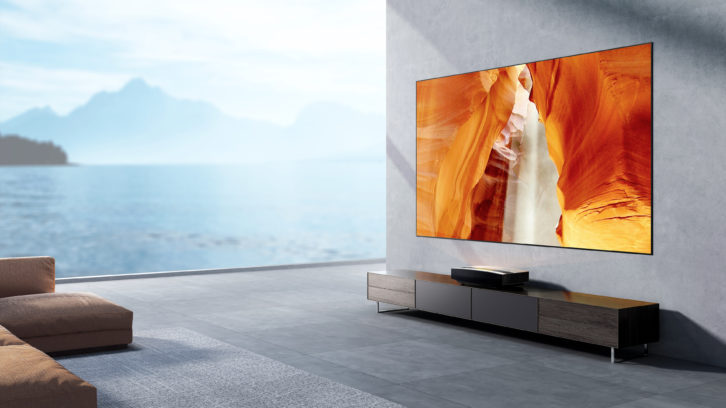
If you’ve seen any adverts for UST projectors, they are often shown in well-lit rooms with ultra-bright images that look like they rival any direct-view display for brightness and contrast. From what I’ve seen in person at trade shows, this is not the case — and especially not with a traditional screen material. Even with my light-controlled living room, images lacked contrast, pop, and detail when watching before sundown or with the lights on. Sure, you could see what was going on, but images were flat and washed out, with no blacks or shadow detail. One saving grace was that most sports — baseball, football, and golf — which often have lots of grass and bright colors, were pretty viewable with some ambient light. Still not like a direct view, but definitely watchable.
To give the Aura its best shot at looking great, I reached out to both Stewart Filmscreen and Screen Innovations and asked them to send me samples of their best UST screen material. In the case of Stewart, that was its BlackHawk UST and for SI it was the Short Throw material. These are similar in spec with 80 to 90 percent ALR, 85-degree half-gain, and .55 to .6 gain, though the SI can have a slighter wider maximum width of 113 inches versus 104.5 inches for Stewart. With both screens, they are white when looking from the bottom-up (as the projector would see it) and black when looking from the top down, where it absorbs ambient light.
Using these materials was a game-changer for day viewing, as they both did a fantastic job rejecting lighting from above and reflecting the lighting from the projector. Still not like a direct-view LED, but way better. And due to their negative gain, these screens also had the added benefit of greatly lowering the black floor of the projector, producing far more cinematic black levels. This was an appreciable black-level improvement whether it was day or night viewing.
While both screens did a great job of retaining color accuracy and saturation, they both noticeably knocked down the overall brightness — SI estimated it is like taking off 1000 lumens. And that was a real performance hit on HDR content. However, this was definitely a better-than-even trade, and if you are planning a UST for a living room, an ALR screen is practically requisite. However, note that either of these screens cost twice what the Aura projector does, so it is raising it to a whole different budget level. (Obviously, there are less-expensive options available.)
As much as these screens improved the picture, it wasn’t possible to actually watch using these sample chunks, so the vast majority of my viewing was on my Draper at night.
Here, I’m of two minds… There is one, John the reviewer, critical of any flaws and shortcomings, and comparing this projected image to others I’ve seen, and weighing if this is something I’d want to purchase. And there are two, John the pragmatist, who views this through the lens of the expectations of what a typical customer might expect.
Reviewer John definitely had issues with the Aura’s video quality. While I had the Aura, I also had Sony’s new VPL-XW5000ES, and it just revealed all of Aura’s shortcomings. Granted, the Sony is almost 2.5-times as expensive, but it really illustrated the quality and performance difference between the two models. Without one of the UST screens, the Aura’s black levels were not as cinematic as I’d like. If the viewing room is pitch black, it is less of an issue, but there was a noticeable difference in black between the edge of the screen where the Aura didn’t fill and the Aura’s black at the edges.
And since the Aura only covers 80 percent of the DCI-P3 color space, it can’t really deliver on HDR’s benefits. Colors — especially greens and yellows — looked pushed and artificial, and with HDR content, colors were occasionally off and desaturated, almost reminding me of component video when the Red cable wasn’t connected.
Review: Epson EpiqVision Mini EF12 Streaming Laser Projector
The Aura is also prone to banding, especially on HD content with blues and grays. We watched Vigil, a series about a British nuclear submarine, on Peacock, and the underwater shots with any lighting repeatedly struggled. And because of the extreme upfiring nature of UST projectors, there was a bit of softness in corner focus, and you would get this white smear of credits/logos when they were up in the corners against black backgrounds. There was also noticeable line twitter when there was movement involving objects with fine detail or patterns, like tight lines in a building or a pinstripe or plaid shirt.
For customers concerned about video quality, they will be better off sticking with a high-end 85-inch LED. For around the same price, the picture quality will be vastly superior, especially with ambient light or when viewing HDR content.
Now, Pragmatic John could see how the Aura could be used in certain non-critical viewing areas like say a kid’s playroom or bedroom. Throw some kids in front of it for streaming or gaming where the image size will be a case of quantity over quality, and they’d be thrilled. And if this is a customer’s first experience with a projector, they will probably be more forgiving of some of its picture quality failings, or if they want to go larger than an 85-inch, but don’t have the budget for a 100-inch LED.
And, despite my criticisms above, we often found ourselves watching the Aura at night over raising the screen and using our 65-inch OLED. What can I say? A good-looking 88-inch image is just more cinematic than a great-looking 65-inch. And on my 1.3 gain screen, the Aura delivered punchy highlights from bright lights streaming in through windows in shows like Andor.
Also, I don’t know if it is the Aura’s lens quality or a byproduct of UST projectors in general, but the Aura could deliver razor-sharp detail that was at times startling. We watched Jerry and Marge Go Large starring Bryan Cranstron and the pores, lines, and crags it revealed in his face were unsettling. This tack-sharp, almost hyper-realistic detail was something we’d notice over and over as the Aura just delivered some incredible, near-startling sharpness and detail in close-ups of faces, fabrics, and textures.
As my first experience with a UST projector, the Xgimi Aura is simultaneously the best and worst I’ve experienced with UST projection, and living with it really showed both the potential and challenges. Pair Aura with a good 120-inch ALR screen and you’ve got a near instant-theater with very little installation and an easy retrofit that would likely satisfy many viewers. Clearly, the category is growing and developing, so it’s worth following and knowing the key players.
833-325-1055; US.XGIMI.COM
Product Specs:
- UST Laser Projector rated at 2400 ANSI lumens with 20,000-hour lifespan
- DLP technology with .47-inch DMD with 3840 x 2160 resolution
- Supports 4K with HDR10 and HLG
- .233:1 throw ratio with auto-focus supports image sizes from 80-120 inches diagonal
- Eight-point keystone correction
- Four-speaker Harman Kardon audio system with 4×15-watt power
- Android TV with Google Assistant and Chromecast built-in
- Inputs: 3 HDMI (1 ARC), 2 USB, RJ45 LAN; Outputs: Toslink, mini-jack audio, detachable power; Dual-band 2.4/5GHz Wi-Fi, Bluetooth 5.0
Dimensions: 23.86 x 5.49 x 15.79 inches (WxHxD)
Weight: 24 pounds
